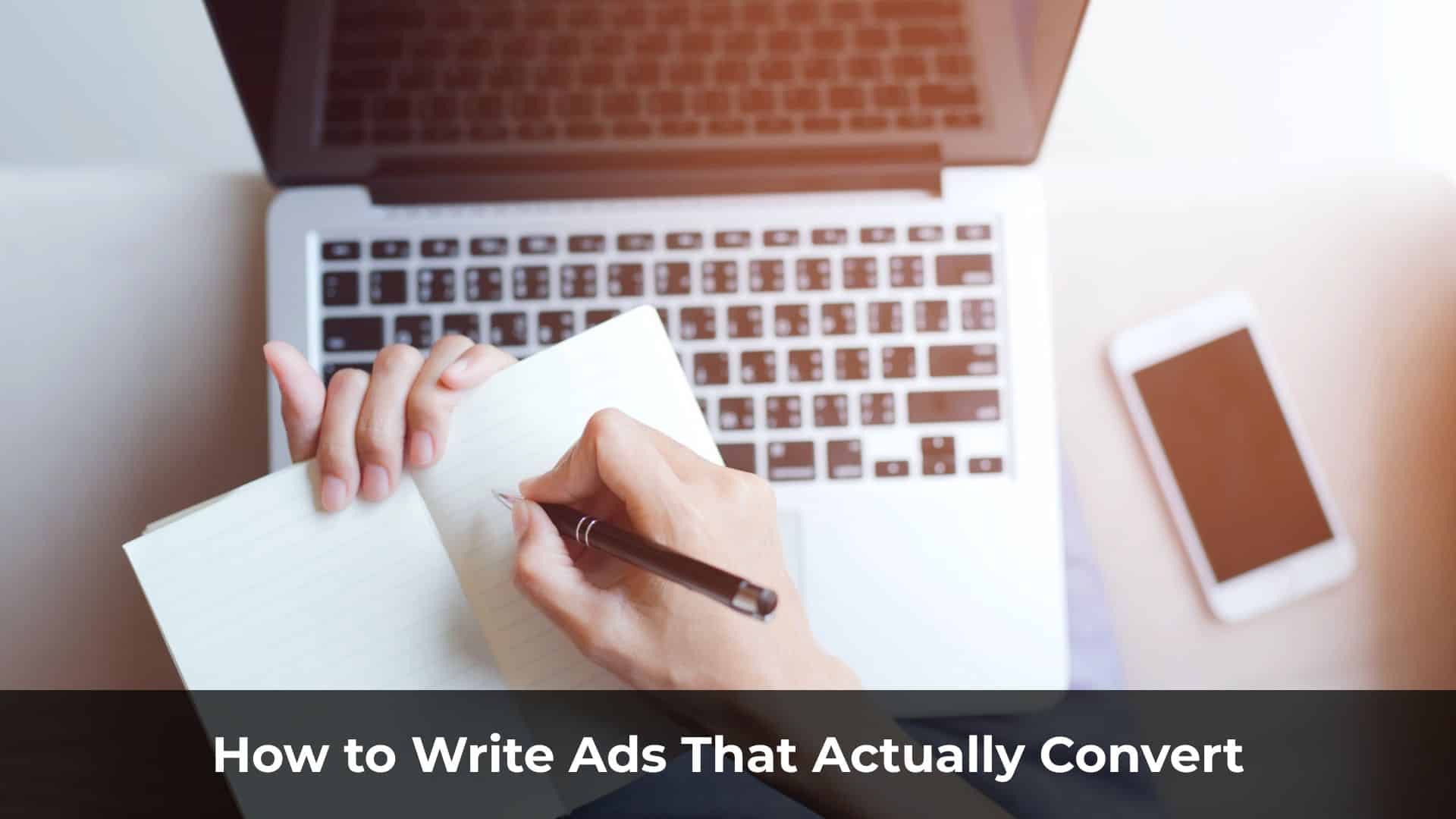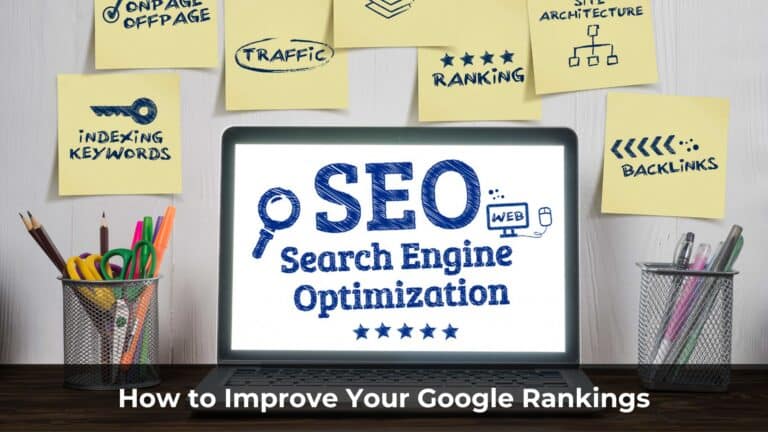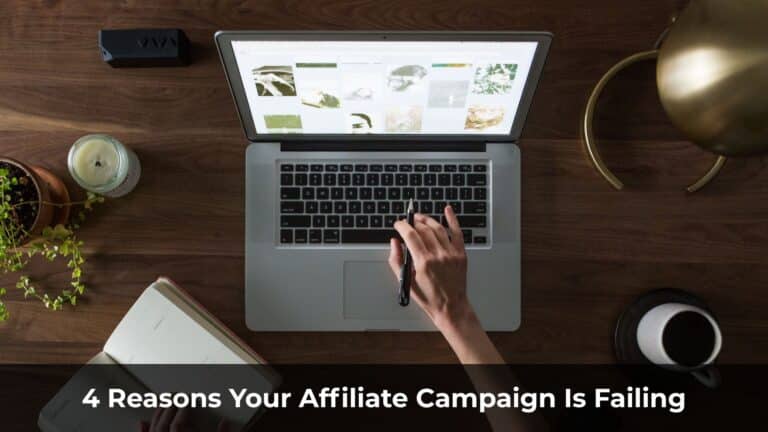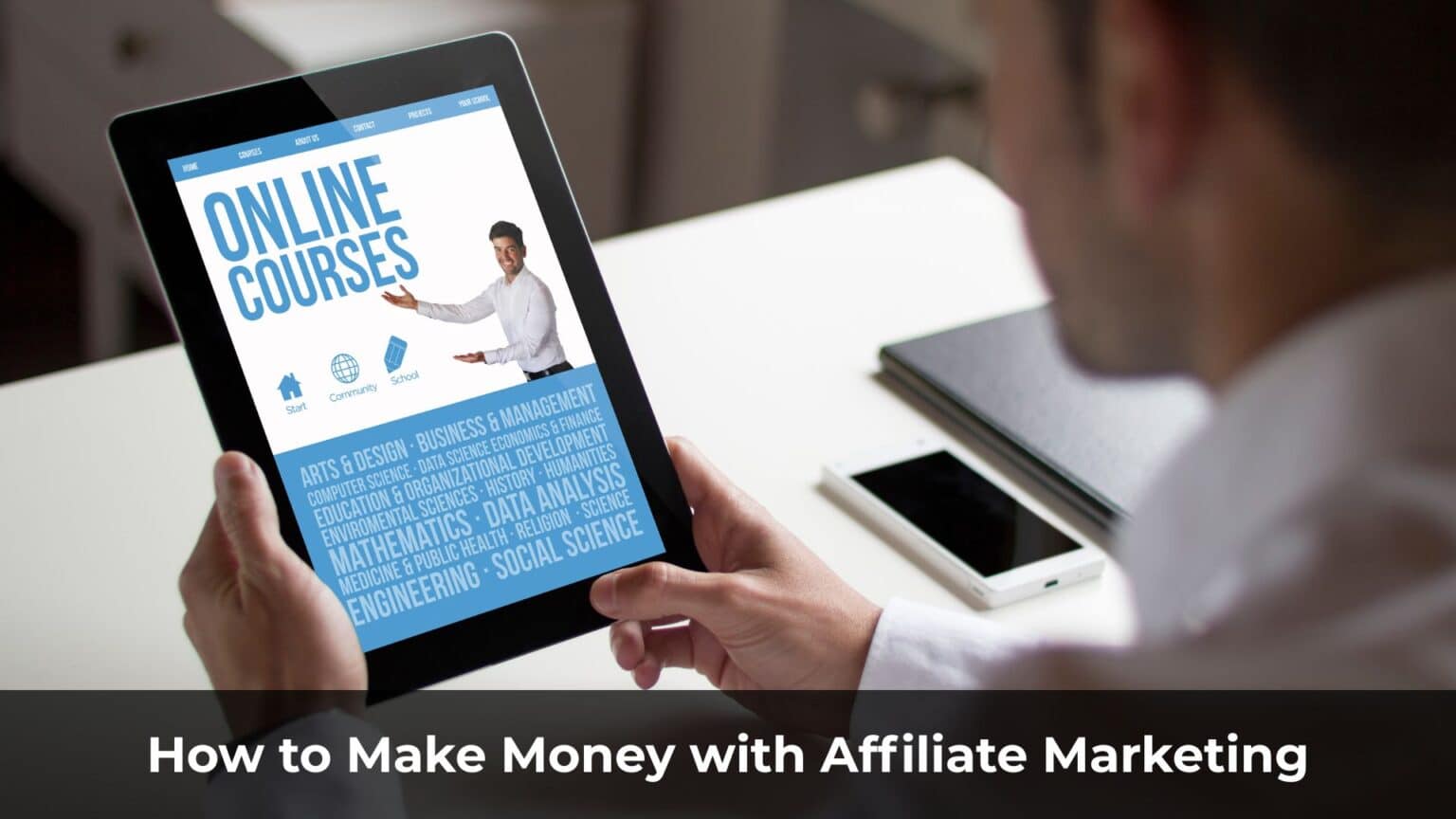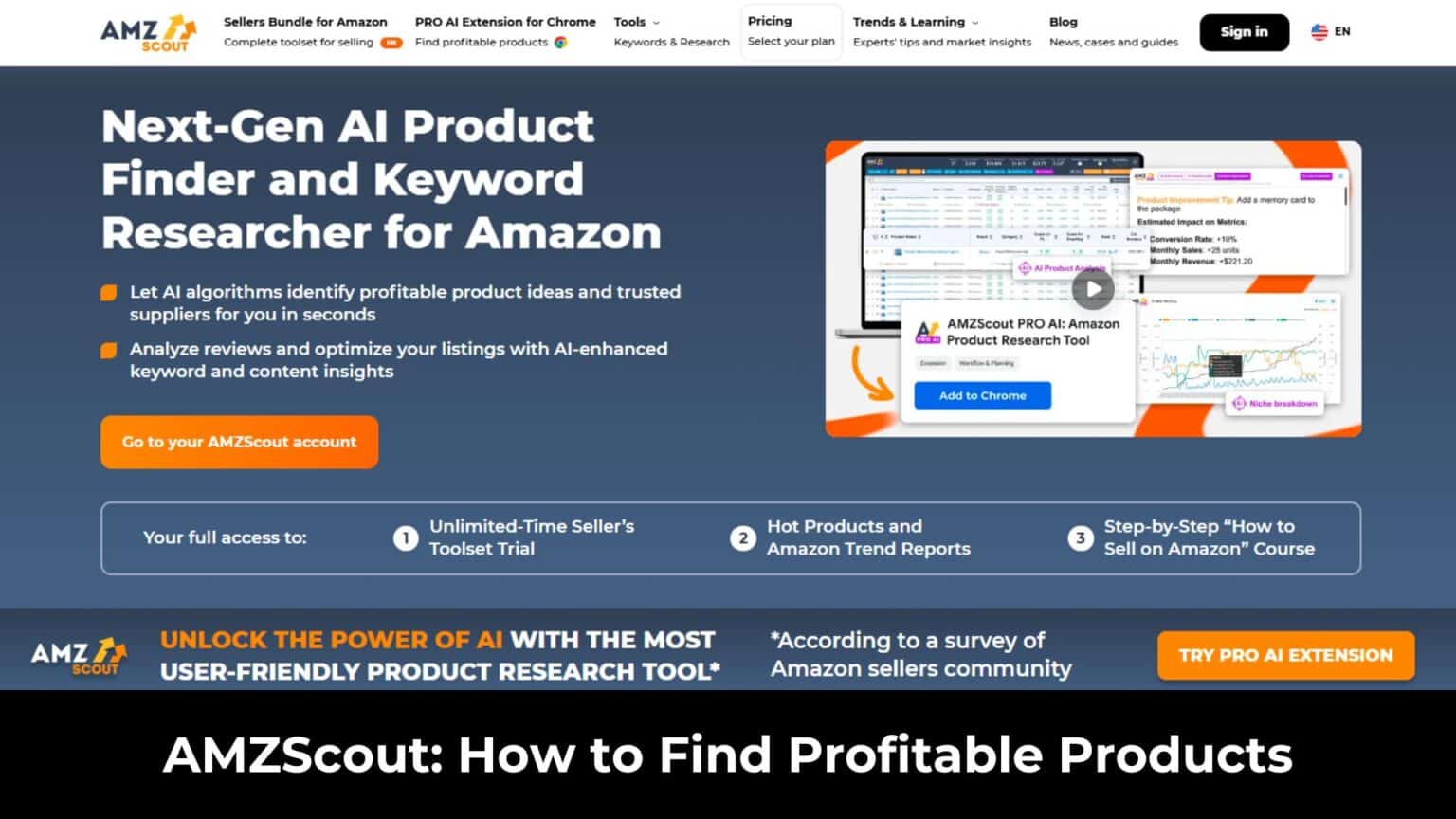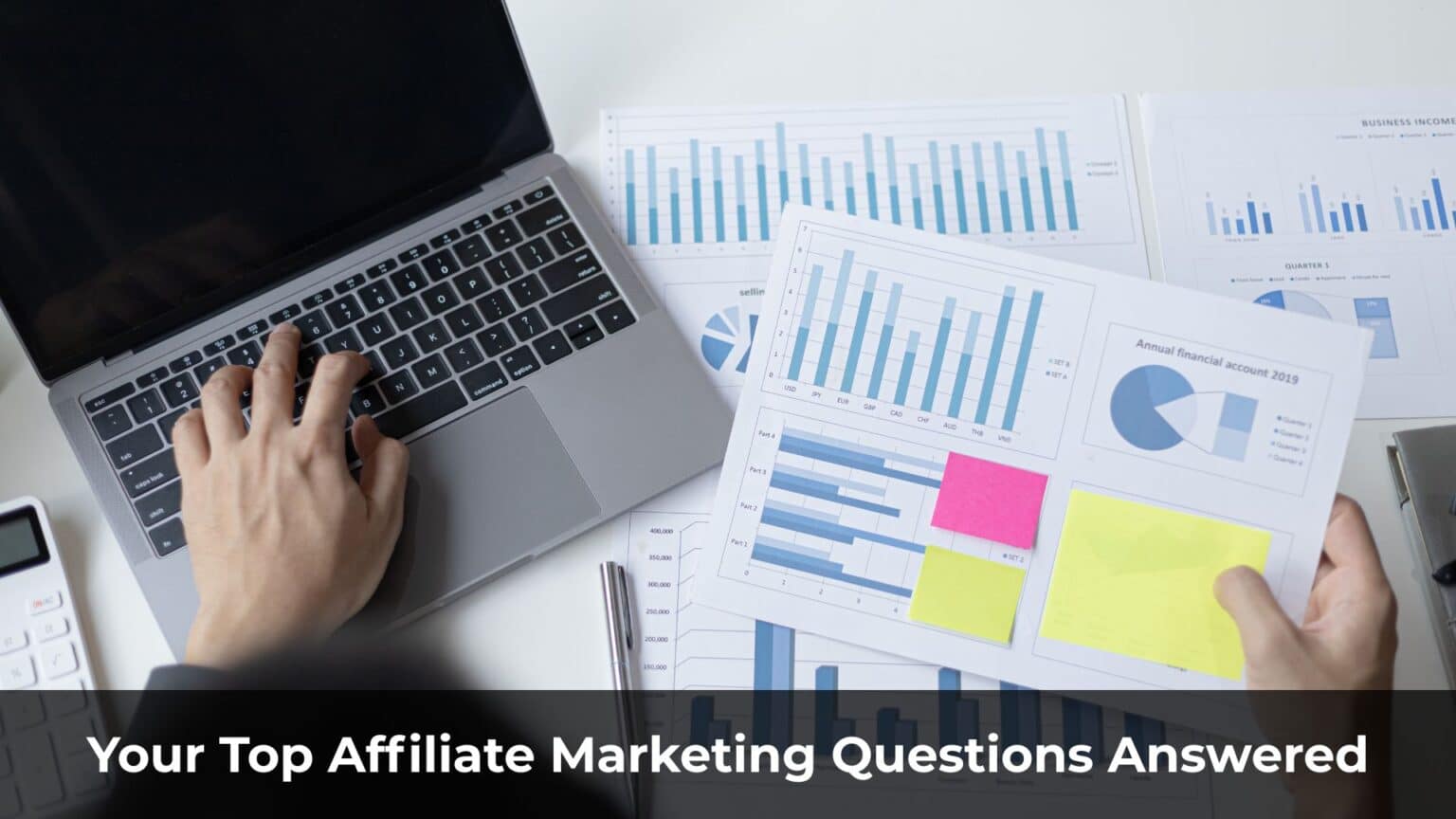“The purpose of the headline is to get the reader to read the first line.
The purpose of the first line is to get them to read the next.”
— Joseph Sugarman
In affiliate marketing, your ad copy is the make-or-break factor for your campaign’s success.
Picture this: A woman is casually scrolling through Facebook when your ad pops up on her screen.
What do you want her to do?
Pull out her credit card? Share her personal information? Sit through a long-form video—maybe even a 40-minute VSL like some ClickBank offers?
None of those actions come easy.
And the only way to make them happen… is through compelling copy. That’s where your copywriting skills come in.
Table of Contents
ToggleA Quick Primer on Copywriting
Copywriting is the art of using words to persuade someone to take a specific action.
Now think about the affiliate marketing funnel you’re building:
- You need a headline that grabs attention and gets people to click your ad. The higher your click-through rate, the lower your cost per click.
- You need a well-crafted landing page that helps users make faster purchase decisions. The better your copy, the stronger your landing page, your ad, and your angle—giving you a serious edge over the competition.
The result? Lower ad costs and higher conversions. That’s your competitive advantage.
Over the past nine years, I’ve written hundreds of ads and landing pages—and read everything from classic copywriting books to advanced persuasion guides.
In this article, I’ll share the top 20% of what actually works—the core principles that deliver 80% of the real-world results.
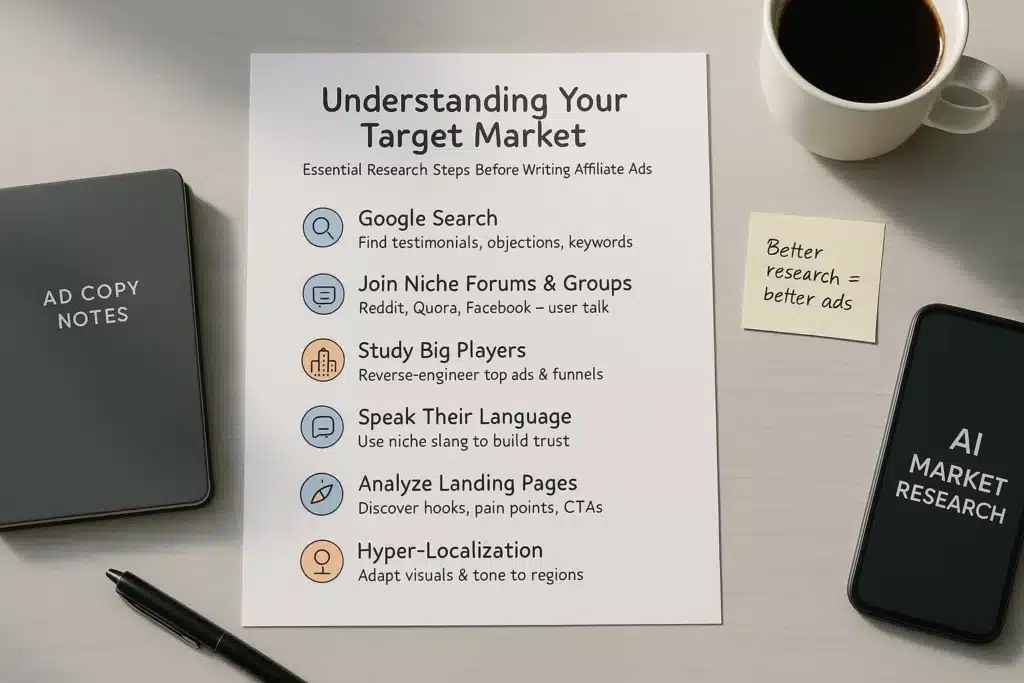
Know Your Target Market Inside Out
Before you write a single word of ad copy, there’s one thing you must get right: deeply understanding your niche.
Let me emphasize that up front.
You can focus on a specific offer later—but the foundation of any successful campaign lies in your mindset and knowledge of the market.
It may sound like old-school marketing advice, but it still works. Especially in affiliate marketing.
Why?
Because the better you understand your niche, the easier it is to uncover your audience’s hidden pain points—and turn those into powerful copy.
Here are some proven ways to get to know your market better:
1. Google the Offer Name
Search the offer name on Google to see what’s already out there.
You’ll find testimonials, unique insights, and selling points you can swipe for your ad angles and landing pages.
2. Join Niche Forums and Online Communities
Forums are where real users talk about real problems.
They’re goldmines for emotional pain points, user language, and common objections.
These days, traditional forums are less active—but Reddit, Quora, and Facebook Groups have taken their place.
3. Analyze Big Players in Your Niche
Even if you’re a small-time affiliate, study how the big companies operate—especially in CPA niches where billion-dollar corporations run ads.
Read their content. Reverse-engineer their funnels. Ask yourself:
“What are they doing? And how can I do it better?”
4. Learn and Use the Right Customer Language
Using the right words builds trust and relatability fast.
Example:
- In U.S. weight loss offers for women, use slang like “muffin top.”
- In smoking cessation, phrases like “quit cold turkey” resonate better.
The more you sound like your audience, the more they’ll listen.
5. Reverse-Engineer the Offer’s Funnel
Translate and study the offer’s landing page and funnel.
Look at how they walk the user through the decision-making process.
You’ll uncover hidden selling points and emotional triggers that you can use directly in your own landing page.
6. Hyper-Local Research
What works in the U.S. might flop in the U.K.
To increase conversions, dig into the local context of your target region:
- Adjust visuals
- Adapt language
- Align with cultural norms
Localization = higher relevance = better performance.
7. Interview Real Users
Once you’ve got a working campaign, take it a step further: talk to your actual customers.
- Show them your landing page and ask for feedback.
- Ask what other products or methods they tried—and why they didn’t work.
- Find out what’s really holding them back from buying—so you can address those exact objections in your ads.
These steps aren’t just research—they’re your unfair advantage.
The better you understand your audience, the more persuasive your copy will be.
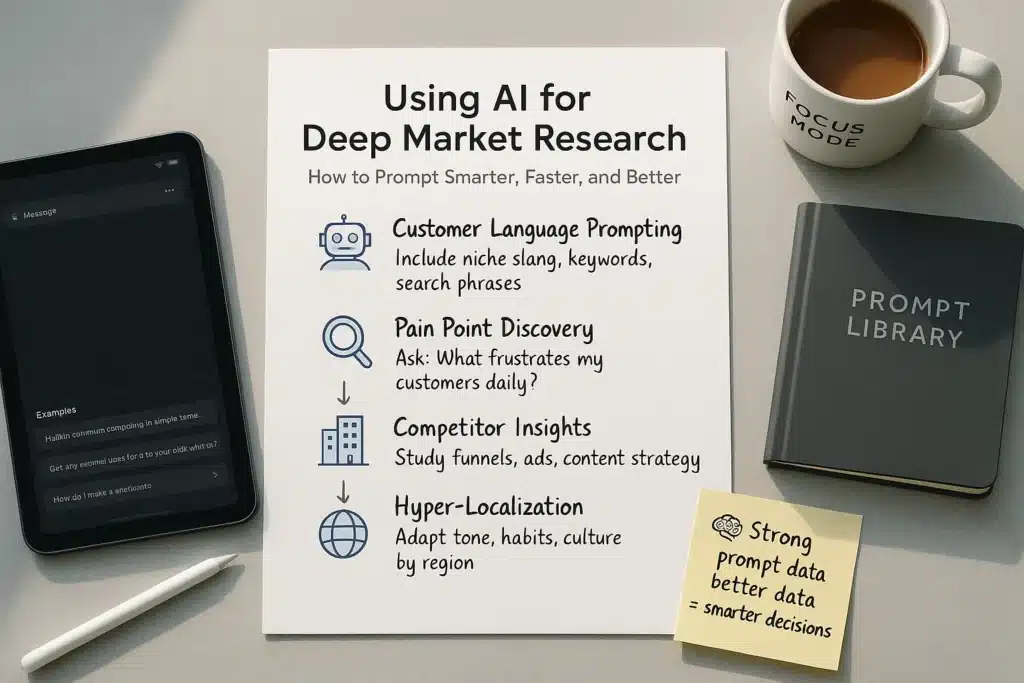
Using AI for Market Research (Deep Research)
If you want a smarter, faster way to do in-depth niche research, advanced AI tools like ChatGPT, Gemini, or Manus AI are game changers.
These tools have deep research capabilities that help you quickly gather rich insights, spot emerging trends, and understand your target audience on a much deeper level.
To get the best results, don’t rely on generic prompts—build your own based on the knowledge you’ve picked up from the previous sections. Specifically, you should include:
- Customer-Specific Language: Add niche keywords and customer lingo to guide AI in the right direction.
- Real Pain Points and Problems: Ask AI to help you surface the actual challenges people in your niche are facing.
- Competitor Insights: Use AI to break down how top companies create content, build funnels, and optimize conversions.
- Hyper-Localized Information: Request AI to provide cultural traits, shopping behaviors, and local terminology that match your target market.
This approach allows you to unlock the full power of AI and perform research that goes far beyond what traditional methods can offer.
Learn more: Content Marketing in the AI Era: How to Build a Scalable Authority Website That Lasts
How to Write Compelling Ad Headlines
Your headline is the very first thing people see—and it’s what determines whether they’ll stop scrolling or keep going.
If your headline doesn’t grab attention, it doesn’t matter how good the rest of your content is. It’ll get ignored.
Personally, I consider headline writing one of the most critical skills in affiliate marketing. It often makes the difference between a profitable campaign and one that flatlines.
Over the years, I’ve written and tested hundreds of ad headlines. I’ve also shared detailed headline formulas and strategies in another deep-dive post.
But here, let me give you the 80/20 techniques—the key methods I use to consistently write high-performing headlines:
- Use Emotionally Charged Words: Words that trigger curiosity or urgency make people act. Examples: “Breakthrough,” “Secret,” “Revealed,” “Instantly.”
- Compare Your Offer to Another: People love comparisons. It helps highlight your advantage immediately.
Example: “Why Thousands Choose X Over Y.” - Ask a Question: Questions pull readers into the copy by making them think.
Example: “Are You Making This Common Weight Loss Mistake?” - Use Proven Headline Formulas: Try classics like PAS (Problem–Agitate–Solution), “How to…,” “X Secrets About…,” or “The Truth About…”
- Speak Your Audience’s Language: Use slang, terms, or inside jokes familiar to your target niche to build instant connection.
- Study Winning Ads: Look at what your competitors are doing well. Analyze their strongest headlines and learn from what’s already working.
- Focus on the Audience’s Main Pain Point: Headlines that speak directly to a real problem will always convert better.
Example: “Hate the Gym But Still Want to Lose Weight?” - Write Lots of Variations: Practice is key. Aim to write at least 25 headline variations for each campaign. The more you write, the better your chances of hitting gold.
Apply these techniques, and you’ll dramatically increase your ability to capture attention—and drive results with your affiliate ads.
9 Key Elements of High-Converting Ad Copy
Copywriting is both a science and an art.
- The science: You can rely on proven formulas, structures, and strategies—and apply them to almost any ad you write.
- The art: There’s no one-size-fits-all blueprint. Every offer is different. Every audience is different. You’ll need to sharpen your own skills and adapt each element based on what your campaign needs.
In this section, I’ll break down how I personally structure my ad copy—and explain why each element plays a critical role in driving conversions.

Benefits vs. Features
One of the most common mistakes I see in online ad copy is this: too much focus on features, not enough on benefits.
Here’s the truth:
Nobody really cares about features.
Sure, professionals and highly informed buyers may look for detailed specs.
But in affiliate marketing—especially when you’re running ads on platforms like Facebook or Native Ads—your audience is mostly regular users, not experts.
They care about just one thing:
“What’s in it for me?”
Only benefits answer that question. Features don’t.
Let’s look at a real example from a lead generation offer in the finance niche:
- Benefit: “Get $10,000 in your bank account to buy a car—starting today!”
- Feature: “5.19% interest rate, 30-month loan term, $150 processing fee.”
See the difference?
The feature list is technical and informative—but it’s boring to most people. It only appeals to those already deep into the buying process.
On the other hand, people who urgently need money don’t care about loan terms right away. They care about the end result—the cash.
Details like interest rates, fees, and terms can be explained later—once the lead has entered your funnel.
Since affiliate marketing is about generating leads, your initial ad copy should focus on selling the benefit, not overwhelming people with product specs.
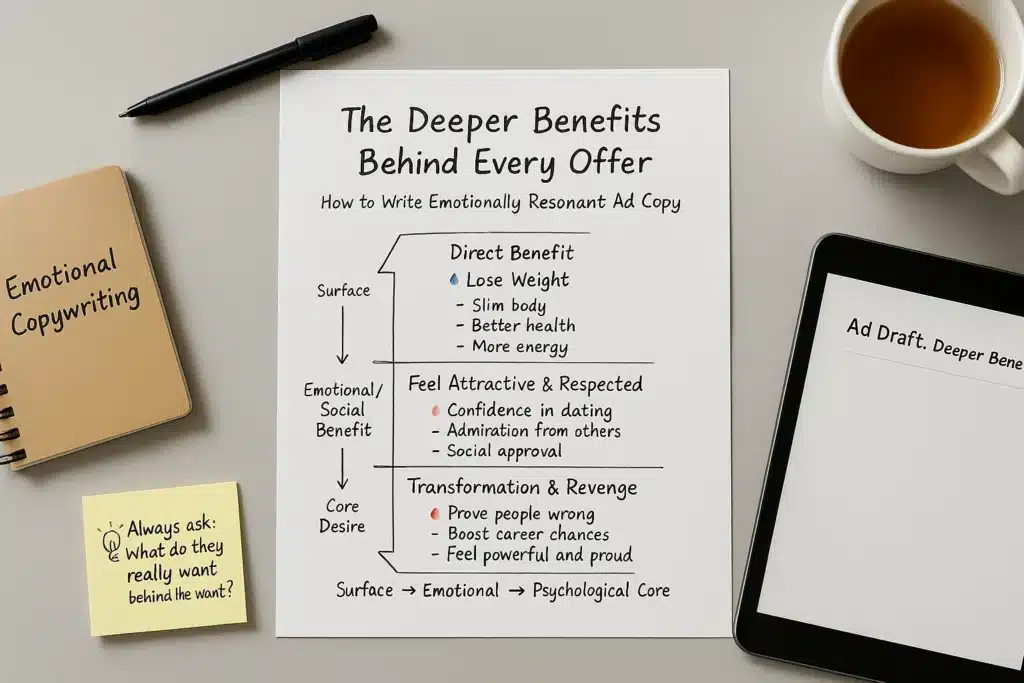
The Benefit of the Benefit
Let’s say you’re promoting a weight loss product.
The direct benefit?
Most people would say: “to get a slimmer, more attractive body.”
Some may also mention health improvements—reducing the risk of heart disease, high blood pressure, or diabetes.
But here’s the thing:
If you want your ad to really convert, you need to go one layer deeper.
What’s the benefit of that benefit?
In other words:
“What does the customer truly want after they achieve this benefit?”
Let’s break it down with a few emotional and social payoffs:
- A fit body makes you more attractive—boosting your chances of finding a dream partner.
- Looking healthier and more energetic earns you more respect—from friends, coworkers, even strangers.
- Confidence skyrockets—and so does your potential for career growth (yes, studies show good-looking people get promoted faster).
- You shock the people who once looked down on you. Some admire you. Others get jealous. Either way, you win.
See what’s happening?
“Losing weight” isn’t the ultimate goal. It’s just a gateway to deeper emotional rewards—love, power, confidence, validation.
That’s what people are really buying.
So in your affiliate ad copy, apply this principle:
Ask yourself:
“What’s the core benefit of this offer?”
Then go further:
“What emotional or social transformation does that benefit lead to?”
Tap into those deeper desires—and you’ll write copy that truly connects and converts.
Keep It Simple and Easy to Read
Here’s the golden rule:
Write so clearly that even a 6-year-old could understand it.
Reading levels vary depending on region and market, so never try to sound fancy or “smart” in your ad copy.
If something feels even slightly confusing, readers will bounce—fast. And just like that, you’ve lost a potential customer.
My go-to tip:
Use HemingwayApp.com to check your writing.
It highlights long and complex sentences so you can tighten things up for clarity and punch:
- Yellow = long sentences
- Red = very hard-to-read sentences
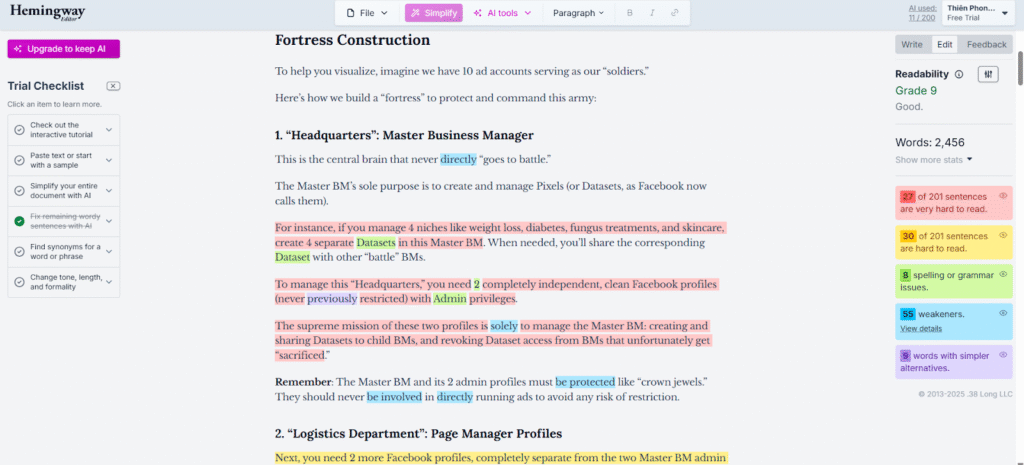
This becomes especially important when you’re writing short-form landing pages or running Facebook and Native ads—where users decide in seconds whether to keep reading or scroll away.
Use Power Words That Grab Attention
Top affiliates use this technique all the time—especially when ad space is tight. A great headline doesn’t ramble. It hits hard and hooks instantly.
So, what are “power words”?
They’re words or phrases that snap people out of distraction—forcing them to stop scrolling and focus on your ad or landing page.
These words evoke emotion, urgency, curiosity, or even shock. And that’s exactly what gets clicks.
Some examples of power words:
- Hardcore
- Free
- Simple
- Shocking
- Blueprint
- Cheat / Cheatsheet
- Insider
- Underground
- Cult
Example of a high-impact headline:
“Shocking Insider-Only Cheatsheet Single Moms Are Using To Dissolve Stubborn Belly Fat.”
Sounds intense? It is. And that’s the point.
In a noisy market, emotional intensity is what drives action.
Remember this:
Two people can tell the same story—
One makes the audience laugh, cry, or feel something.
The other puts them to sleep.
The ad game is more competitive than ever. Everyone’s fighting for attention. This is not the time to be timid.
You only get one shot to make an impression. So go bold.
Hit emotions. And earn the click.

Leverage Pain and Desire
Here’s the truth:
People rarely buy when they’re perfectly satisfied.
They buy because they want more. They want to upgrade their life, fix what’s broken, get ahead—or simply avoid falling behind.
So instead of only highlighting the benefits, tap into the negative side too: the pain, the fear, the consequences of not taking action.
Ask questions like:
- What happens if they miss this opportunity?
- What will they lose if they don’t buy?
- How will it feel when others succeed—and they’re stuck in the same place?
This technique has worked wonders for me in affiliate campaigns.
For example:
When promoting a lead gen offer in the insurance niche, don’t just talk about “feeling safe.” That’s too soft.
Instead, hit the pain points:
- “What if a single accident wipes out your entire life savings—and you’re not covered?”
- “Could you afford to lose your $400,000 car because of one minor crash?”
By highlighting the risks and potential losses, you trigger a stronger emotional response—one that pushes people to take action now, not later.
Personalize the Message to the Reader
Many native ad affiliates use user personalization tactics on their landing pages—but this technique is often overlooked on long-form pages, where it can be even more powerful.
With a proper setup, you can dynamically insert personal info into your page:
Device type, city, country, ISP, language, even profession.
But even without tracking tools, you can still create the feeling of personalization.
How?
Simple: use personal pronouns like you, I, we, us, or even your community.
People respond better when it feels like the page is speaking directly to them.
This is also why the “us vs. them” writing style works so well in direct response copy:
“We” (you and your reader) vs. “Them” (the big corporations, the system, the villains).
Example:
In many weight loss landing pages, copywriters target a common enemy—like big food companies or government regulators.
They’ll describe how “they” profit from unhealthy food and suppress natural weight-loss solutions to protect their interests.
It’s effective because it builds emotional connection, trust, and even a sense of rebellion.
Pro tip:
Create a crystal-clear customer avatar before you write.
It will help you tailor your message, tone, and angle to hit your niche audience right where it matters.
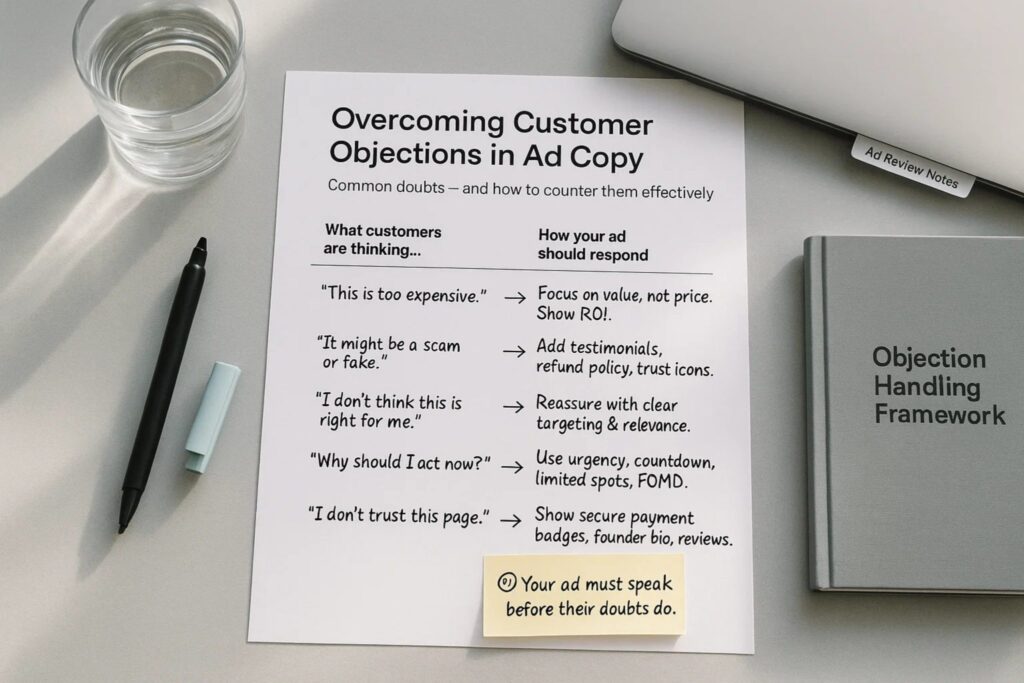
Overcoming Customer Objections
When someone reads your ad copy, their brain doesn’t just sit there absorbing every word.
They’re actively trying to poke holes in it.
They’re thinking:
- “Why should I believe this?”
- “Is this product really worth my money?”
- “Who even wrote this, and why should I trust them?”
- “Maybe I should save that money for something else.”
- “What should I eat for dinner tonight?”
You might think your copy is great—but is it strong enough to convince a real, skeptical, distracted human?
To increase conversions, you need to anticipate and overcome objections before they’re even spoken.
Let’s break down some common objections—and how to handle them:
“This product is too expensive.”
→ Focus on the value, not the price. Frame the cost as an investment with a clear payoff.
“It probably doesn’t work like the ad claims.”
→ Use real testimonials, guarantee badges, certifications, and any social proof you have to build trust.
“I’m not sure this is right for me.”
→ Show that you understand their problem. Highlight how the product was designed specifically for people like them—with tight targeting and deep research.
“Why should I buy right now?”
→ Add urgency. Flash sales, countdown timers, limited bonuses, or FOMO messaging can make a huge difference.
“I don’t trust this site or seller.”
→ Add credibility triggers:
Safe payment logos, SSL seals, transparent company info, testimonials, and founder introductions all help reduce friction.
Every doubt you remove = one step closer to the sale.
So as you write, put yourself in your customer’s head—and knock down their objections before they even finish thinking them.
Use Storytelling to Sell
Here’s the truth:
No one likes reading ads—
But everyone loves a good story.
If you’re promoting a low-ticket offer or need fast conversions, storytelling might not be essential. But for high-ticket products and long-form landing pages, storytelling is one of the most powerful tools you can use.
Why? Because stories hold attention.
They draw people in emotionally and guide them toward a buying decision—without sounding like a hard pitch.
Selling through story is a craft.
And like any skill, it takes practice to master.
Here are a few powerful resources to help you learn how storytelling works in sales:
- “How a Hollywood Movie Increases Army Signups” – A real-life case study on emotional influence and action.
- “Coat of Arms” – A classic ad example built entirely on narrative.
- “Two Young Men” – One of the most iconic sales stories ever written.
If you study top-performing sales pages on platforms like ClickBank, you’ll notice one thing:
Most of them use story.
It’s not just fluff—it’s a strategic way to shift the reader’s mindset, lower resistance, and create a buying impulse that feels natural, not forced.
People don’t like being sold to.
But they do like feeling something.
That’s what great storytelling delivers.
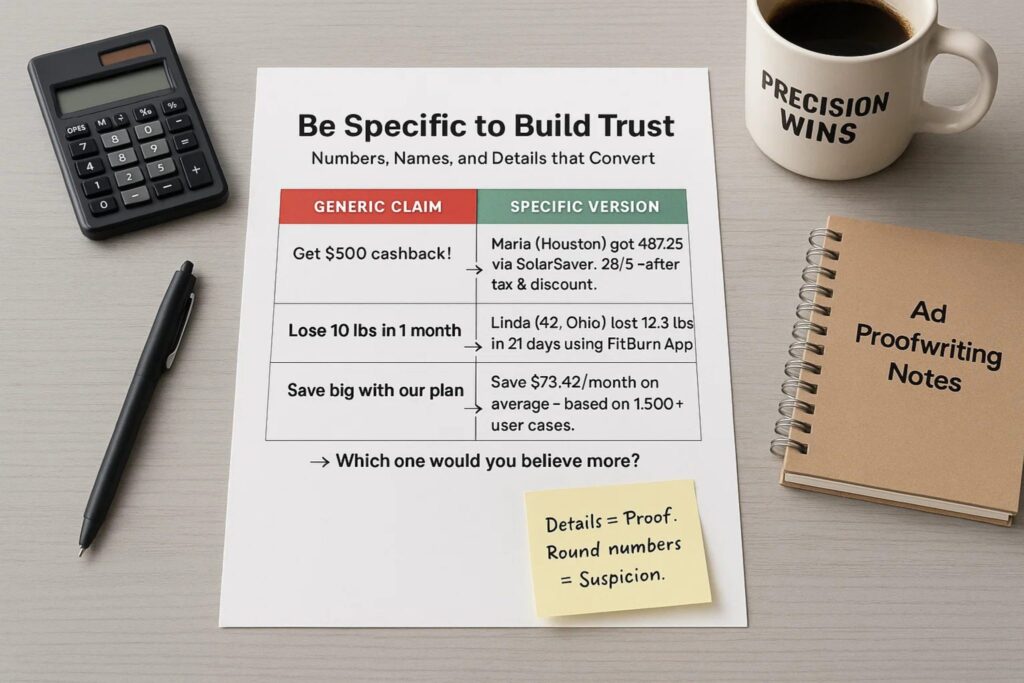
Use Specific Words and Numbers to Build Trust
Simple rule:
The more specific you are, the more believable you sound.
Have you ever seen ads like:
“Get $500 cashback when you install solar panels!”
Sure, it sounds appealing—but also a bit fake.
Why? Because $500 is a perfectly round number. It feels made up—like marketing fluff.
Now compare these two headlines:
- “Get $500 cashback on solar installation.”
- “Maria from Houston, TX received exactly $487.25 cashback through the SolarSaver program on May 28—after taxes and rebates from XPower Energy.”
Which one would you trust more?
The second one wins—easily.
It includes the exact amount, the location, the date, the name of the program, and even the energy provider.
Specifics make the story feel real.
They remove doubt and add instant credibility.
Here are some simple ways to boost trust and conversions using specificity:
- Use exact numbers, not rounded estimates. “Lost 10.6 lbs” sounds measured and real.
“Lost 10 lbs” sounds like a guess. - Mention real people—not generic placeholders. Instead of: “A woman in the U.S. successfully lost weight…”
Say: “Linda, 42, from Ohio, lost 12.3 pounds in just 21 days…” - Explain the why and how.
Once your headline and hook grab attention, take your time to explain exactly how it works.
Curious readers stay longer—and longer time on page often means higher conversion.
Specificity is one of the most underrated weapons in copywriting.
It builds trust, adds realism, and makes your content feel researched and legit—not just another hype-driven sales pitch.
Call to Action (CTA): Closing the Sale
The CTA is the final moment in your ad—but here’s something most beginners forget:
The button doesn’t sell. Your copy does.
By the time someone reaches your CTA, they’ve already decided whether to buy or not.
A strong ad “sells” from the headline, the hook, and every section in between. The CTA is just the final nudge after trust and emotion have been built.
Here are a few tactics to boost conversions with better CTAs:
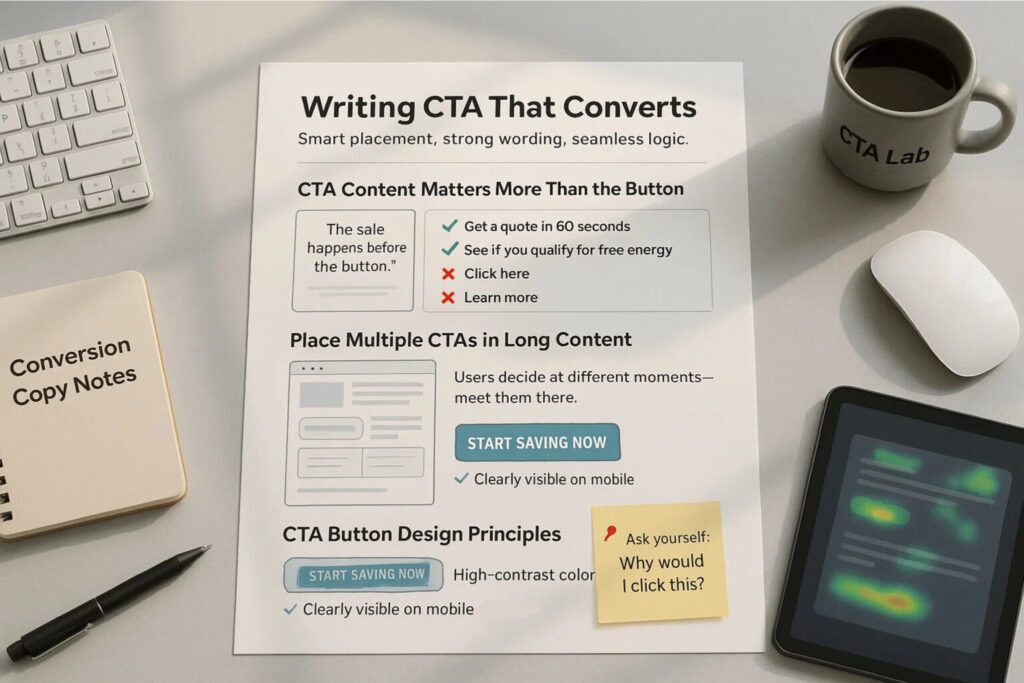
Make Your CTA Benefit-Driven
Avoid vague phrases like:
“Click here”
“Download now”
“Learn more”
Instead, tie the CTA directly to what the user actually gets. Examples:
- “Get your car insurance quote in under 60 seconds”
- “Check if you qualify for free energy credits”
- “See how Mai got $487 cashback from a solar program”
Pro tip: Always ask yourself, “Why would I click this?”
If the answer isn’t obvious, rewrite it.
Use Multiple CTAs on Long Pages
If you’re writing long-form landing pages, add CTAs at strategic points:
- After explaining the main benefit
- After a testimonial or case study
- Before the FAQ section
- And, of course, at the very end
Not everyone scrolls to the bottom—so give users multiple chances to act when they’re ready.
Design CTAs That Stand Out
Your CTA should be easy to find, easy to click, and impossible to ignore.
Tips:
- Use a contrasting color that pops off the background
- Clear borders, bold or uppercase text (don’t overdo it)
- Make it big enough to notice on mobile
- Bonus: Use emotional or benefit-driven images as CTAs, not just buttons
Tools like Hotjar or Microsoft Clarity can show you where users are clicking—so you can optimize based on actual behavior.
Don’t treat your CTA as an afterthought.
Treat it as the natural conclusion of a persuasive flow—where every sentence before it has done the heavy lifting.
When that’s done right, the click becomes almost automatic.

Using AI to Write Ads in Affiliate Marketing: Real-World Tips
In the age of AI, you no longer have to spend hours wrestling with every line of copy. Tools like ChatGPT, Gemini, and Claude can generate 10–20 variations of headlines, angles, and CTAs in minutes.
But here’s the critical point:
AI can’t replace your thinking—it only reflects it.
If you don’t understand the product, the customer’s pain points, or the real benefits behind your offer, AI will just give you generic, lifeless content that sounds like everything else online.
Here are some real-world strategies for using AI effectively in affiliate ad writing:
Start With Strong Input
Before you ask AI to “write an ad,” get clear on the essentials:
- What exactly is the offer?
- Who’s the target audience?
- What problem are they facing?
- Why should they take action today?
Map this out first. Even write a few rough lines by hand—then ask AI to help you expand or refine them.
You Choose the Direction—AI Just Accelerates It
Don’t let AI make all the decisions.
You should be the strategist—AI is just your speed assistant.
Start with a rough outline, then use prompts like:
- “Make this opening line more emotionally compelling.”
- “Focus on the financial pain, not the features.”
- “Keep the CTA as-is, but rewrite the lead to grab attention faster.”
Treat the AI like your junior copywriter—and talk to it the way you would guide a real team member.
Use AI for Variations and Split Testing
Once you’ve nailed a solid angle, let AI generate 5–10 alternative versions.
Pick 2–3 of the strongest to run A/B tests.
Let the data show you which message truly resonates.
When You’re Stuck, Return to the Fundamentals
This article isn’t just a guide—it’s your foundational playbook.
Every time you feel stuck…
Every time the ideas dry up…
Every time technical work pulls you away from real strategy…
Come back here.
Refocus on what matters: your customer, their pain, and how your offer truly helps.
AI is a powerful assistant—but you are still the driver.
Know your product. Know your audience.
Then use AI to amplify your thinking—not replace it.
Copywriting Is a Skill Worth Investing In
Let’s be blunt—if you want to write great ads, you need to take your practice seriously.
And by “practice,” I don’t mean casually writing a few lines and calling it a day.
I mean:
- Writing multiple variations
- Launching real campaigns
- Watching how they perform in the wild
- Split testing relentlessly to see what actually converts
- Analyzing real user behavior in your target market
Affiliate marketing isn’t a one-size-fits-all game. You might run:
- Auto or home insurance (Lead Gen)
- Mobile app installs
- E-commerce product offers
- Digital or physical products from ClickBank
- Solar panel installations
- Auto loan offers
- Mortgage refinance programs
- Credit repair services
- Home utility sign-ups (Internet/TV/Phone)
- Medicare or health insurance consultations
Each offer, each niche, each region—requires a completely different writing style.
That’s why I don’t recommend outsourcing copywriting too early.
Learn it yourself first.
Once you understand what works and what doesn’t, you’ll be in a much better position to hire others—and guide them with clarity and precision.
Copywriting doesn’t just help you make money.
It helps you understand your customers.
It helps you understand the market.
And in the process—it helps you understand yourself, one campaign at a time.
This is a skill worth mastering.
Start investing in it today.
